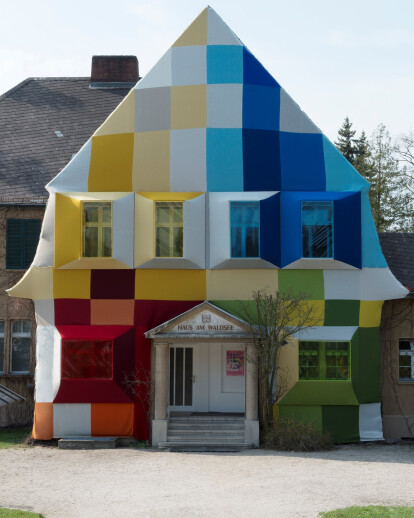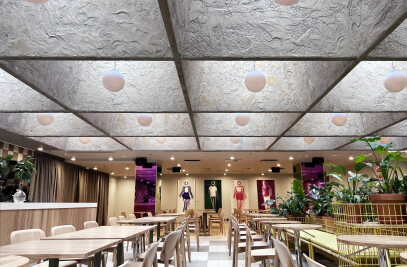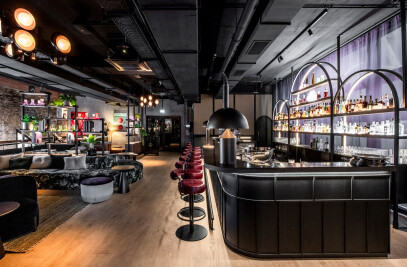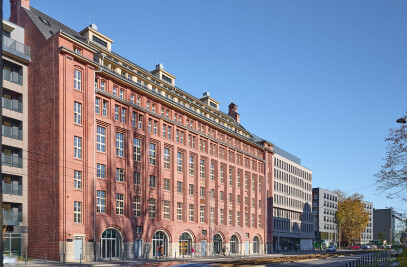The future doesn't lie in the invention of something new but rather in the reinvention of the old. This up-cycling and tuning is the focus of product designer Werner Aisslinger. Under the curation of Katja Blomberg, the museum “Haus am Waldsee” will exhibit Aisslinger’s ideas for the “Home of the Future” from April 21st to June 9th, 2013. Freed from the commercial restraints of industry, the designer can within this artistic context give free rein to his visions of utopia. He transforms the floors of the museum into two sections. On the ground floor, he shows new installations created specifically for the house. In five different living situations, the installations display how one can utilize the latest technical materials to achieve the goal of sustainability. On the upper floor, a retrospective of the designer’s work further explores this question. The Wilhelmian villa is set to become a laboratory of the future.
The “Home of the Future” like all of Werner Aisslinger's works is derived from the basic premise that the design archetypes have been defined by modernity, however the language of forms has outpaced materials development. Aisslinger amends the dictate “form follows function” with “function follows material”. Aisslinger calls this optimization process up-cycling. For him, staying true to the materials is never just about the product, but about the entire environment. Aisslinger is looking to create a symbiotic relationship between the most innovative technology and nature. For the cantilever chair, instead of an environmentally harmful plastic, he used a newly developed, completely biodegradable, composite material. While in the bathroom, steam is routed through a moisture absorbing material which in turn hydrates the plants.
Right from the start, the exterior view of the “Haus am Waldsee” sets the basic tone for the exhibition – up-cycling the way we live. The brick portal is covered with a patchwork wool material which frees the house from its historical captivity. A sports car from the 1970s sheathed in the same fabric is parked in front of the facade. This partner look comments on (and parodies) the middle-class status mantra: “my house, my car, my dog...” It's difficult to get past this complex, but one can certainly approach it differently.
In the foyer of the house, a wallpaper of photos shows glimpses of historic utopias which strove to rethink the housing and living complex. Werner Aisslinger's mentors jump out at the visitor in a colorful mix of patterns.
In the adjoining room, Aisslinger presents the Chair Farm – one of his most forward-thinking ideas. How can you plant products in plantations? In a hollow frame in the shape of a chair, plants have been allowed to grow. Man designs the furniture, nature then takes over the implementation. Fantasy? Werner Aisslinger already sees the next step – plants which without any additional assistance form to the shape of a piece of furniture because it has been engineered into their DNA.
In the second room, elements from urban farming and aquaponics transform the kitchen into an alchemy chamber. Food is produced instead of processed, mushrooms are harvested from coffee grounds and fish excrement fertilizes a vegetable garden – all of it in a greenhouse-like shelf biotope.
The next two rooms are seeking solutions for the regeneration, recovery, retreat complex. A movable plastic mountain encloses the individual in a honeycomb structure which brings the visitor back to nature more convincingly than the basic square form. The anti-digital room encourages the view out of the window instead of at the display screen. From a set of sofa stairs, the visitor looks over a table of wonders (as analogy for the “Wunderkammer”), full of objects, plants and models from the haptic world and into the garden adjoining the “Haus am Waldsee”.
Bathrooms should be tiled and moisture repellent? In the last room on the ground floor, Werner Aisslinger has installed soft textile bathroom elements that are flexible and moisture absorbent. The inspiration for the material comes from the Namib Desert beetle. This beetle collects and stores the morning mist for later use. Similarly, the bathroom material stores the shower steam, and then passes it on to the plants. The material is so flexible that it can be rolled up and adjusted to the height of any sink or shower stall edge. Just like the kitchen, the bathroom of the future can also be a resourceful and sustainable greenhouse.
The retrospective upstairs displays individual objects which continue the themes introduced in the ground floor installations. Modern materials and production techniques are removed from their original manufacturing purposes and used for furniture hybrids which reconcile advanced technology with the principles of nature. Aisslinger's famous Juli Chair from 1996 can be seen here, as well as his Mesh vases, his furniture with gel implants, and the Hemp Chair.
Werner Aisslinger was born in 1964 in Nördlingen, Germany. Today, he lives and works in Berlin. A catalogue of the exhibition will be published by Walther König in German and English.

































